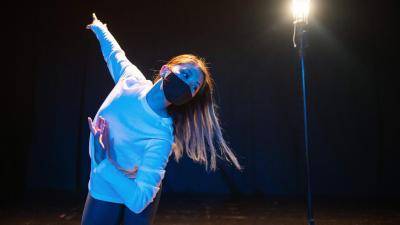As dance artists, it is important for us to look at choreography in the larger context of contemporary art, considering the historical connections in the art we make. One of my favorite movements in modern art is Dadaism (or Dada). The idea of incongruent elements accidentally coming together always fascinated me. The Dadaist movement arose out of hard times - the horrors of World War I, as well as dissatisfaction with the establishment among artists. In many ways our current times echo that era of 100 years ago.
What appealed to me most about Dadaism as an art history student in college, was the game Cadavre Exquis (Exquisite Corpse) in which a group of artists folded a piece of paper and each drew a different part of the same body without seeing what the other artists had created. Picture, if you will, artists gathered in a French Café a century ago creating these sometimes odd, child-like drawings in defiance of the art establishment. In the end, unfolding the paper, a crazy, surreal mash-up of disparate visions and styles of drawing was revealed. Voilá – instant accidental art!
100 years from now, dance scholars will look back at this time as an explosion of creativity in dance.
This concept intrigued me so much that eventually I experimented with it as a choreographic device in group pieces, asking dancers to choreograph phrases to be connected with the phrases of other dancers…all created sight unseen. The resulting sections of choreography were unique, unpredictable and unlike anything I could have choreographed on my own. For me, this device never fails to result in something intriguing and fresh.
I have felt a bit alone in my love of this device, so I was delighted to see a Facebook post in mid-March by Sonoma County dancer/choreographer/visual artist, Jordan Hayes, calling on her COVID-19-sequestered dance friends to submit short phrases of choreography to a selected piece of music for a Cadavre Exquis video project. Her intention was to compile the clips into a non-stop dance, Exquisite Corpse style. Considering Jordan’s work as an artist, photographer, and choreographer, I eagerly anticipated the reveal.
Knowing some of the dancers who would contribute, I imagined the finished product would be quirky and fun. When posted on Facebook, I thought it would probably not be taken seriously as “important” contemporary art by many viewers. But, in the context of its roots in a movement in art history that arose out of social dis-rest and dissatisfaction with the status quo (also the social milieu of our time), I felt in my bones that Jordan’s film project was going to be more than an idle amusement.
Now that Jordan’s project has been unveiled, for me, it exemplifies an innovative application of Cadavre Exquis, but beyond that, it represents a poignant and joyful reflection of a uniquely transformational time for the art of dance.
100 years from now, dance scholars will look back at this time as an explosion of creativity in dance. I believe art historians will view the 2020 pandemic as an important period for art in general. Jordan’s project is part of a movement in contemporary art that is unfolding as we speak - a unique moment in the dance world in which creativity and technology are filling the gap in human contact, forcing dance artists to make their art in ways they never imagined they would.
À votre santé!



